This article includes a list of references, related reading, or external links, but its sources remain unclear because it lacks inline citations .(October 2021) |
This article includes a list of references, related reading, or external links, but its sources remain unclear because it lacks inline citations .(October 2021) |
In 1547 the river that flowed northwest into Lake Tacarigua (today, Lake Valencia) was first seen by the expeditionary Juan de Villegas and the other men he commanded when they took possession of these lands.
Since ancient times, the cities of the far east and the old world, were founded in the vicinity of a river. This custom spread to the New World. In this way, Nueva Valencia del Rey was founded, near Lake Tacarigua, a paradisiacal reservoir of botany, animals, and life when discovered by the conquerors, bathed by a generous river, in most of the houses and in the customs and hearts of its inhabitants.
In 1814, the river had great importance because during that year, the city was besieged twice by royalist forces. These forces took the river which was the only water supply site. A Valencian heroine, María Josefa Zabaleta y Gedler, distinguished herself by risking her life, seeking water from the river to supply the patriots.
In 1818, the first bridge across the river was finished. By 1848, work on an aqueduct was completed; to the surprise of many, the ravine called "La Represa", originally in Guataparo Arriba, was inadequate for the local population of the time. In 1877 a new aqueduct called "Guzmán Blanco" was built. "Guzmán Blanco" was added to the volume of the previous stream, La Represa, that of the Luvara ravine, also originated in Guataparo Arriba. In 1888 "Guzmán Blanco" was, from the same place, the flow called Cacaíto.
In 1979, the Cabriales River was diverted by the Environment Ministry to Lake Valencia, which has contributed to the increase in its level by about 30 centimeters per year.
Currently the Cabriales River manifests itself in Valencian society only as a hydrographic place in the area. It has relevance for some scientists and environmentalists, who try to solve, encourage and raise awareness among the people regarding the problem of the river.
To the surprise of many, the Cabriales River previously mattered and had relevance in the social life of the city, which claimed that it constituted a kind of regional geographical symbol.
During the years of Spain's conquest and colonization, to the Venezuelan coasts and after, during the War of Independence, the Cabriales River formed a point of security from assaults and piracy. It was a place favored by its distance from the sea, its vast extension and its proximity to Lake Tacarigua.
From this river, the inhabitants were supplied with water for their domestic needs and farmers and landowners for their crops and farms. Humble women turned to the river to wash their clothes and all who wanted sand, to bathe beasts and fish for pleasure or for the value of fish proteins. From its flow they perceived the daily sustenance of water vendors or haulers.
It was also relevant for the depressed and suicidal who found liberation from their sorrows and problems in the river. Towards the sunset of a date already forgotten, the inert body of Lady Zedhernán moved and impacted the citizens. Lady Zedhernán was a beautiful Valencian whose suicide in the Cabriales was the oldest suicide of which there is memory. The reason for her suicide was explained by the luxurious fan she kept tight in her hands, illustrated with a Japanese watercolor, which had been sent to her by the Liberator, named Simón Bolívar, inside an onyx case and along with a letter, the day after she met him at a dance on January 4, 1827, the last visit she made to Venezuela.
In addition to the suicidal, there were those who, while death came for them, came to the remote areas of the river to unleash their tears. A well-known example of this was the case of Enrique Linares Irigoyen, who spent many hours devoted to the memory of his son, whom he had lost. He contracted the blood disease that destroyed him within hours. This disease was the one that took the life of his son and, later, that of his daughter and that of his own father.
Many poets, musicians and painters have broken down literary pieces of admiration and art to the Cabriales River. Among the most outstanding painters are Leopoldo La Madriz, Braulio Salazar and Guarenas.
In the poetic genre, the following was emphasized:
During his term as governor of Carabobo, Henrique Salas Römer decreed the "Cabriales Festivals", which mixed music with painting.

Valencia is the capital of the province and autonomous community of the same name in Spain. It is the third-most populated municipality in the country, with 807,693 inhabitants within commune, 1,582,387 inhabitants within the urban area and 2,522,383 inhabitants within the metropolitan region. It is located on the banks of the Turia, on the east coast of the Iberian Peninsula on the Mediterranean Sea.

Valencia is the capital city of Carabobo State and the third-largest city in Venezuela.

Carabobo State is one of the 23 states of Venezuela, located in the north of the country, about two hours by car from Caracas. The state capital city is Valencia, which is also the country's main industrial center. The state's area is 4,369 km2 (1,687 sq mi) and as of the 2011 census, had a population of 2,245,744.

Lake Valencia, formerly Lake Tacarigua, is a lake within Carabobo State and Aragua State in northern Venezuela.
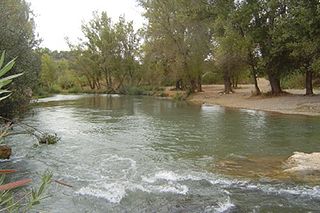
The Turia or Túria is a river in Spain, which has its source in the Montes Universales in the mountain ranges of the northwesternmost end of the Sistema Ibérico, Teruel province. From its source to roughly the city of Teruel, it is called Guadalaviar river. It runs through the provinces of Teruel, Cuenca and Valencia, and discharges into the Mediterranean Sea near the city of Valencia. The river formerly ran through the center of the city but was diverted south of the city to prevent flooding.
The Rímac River is located in western Peru and is the most important source of potable water for the Lima and Callao Metropolitan Area. It belongs to the Pacific Slope, into which it flows after bathing the cities of Lima and Callao, together with the Chillón River, to the north, and the Lurín River, to the south. It is 204 km long and has a basin of 3,312 km², of which 2,237.2 km² is a humid basin. The basin has a total of 191 lagoons, of which only 89 have been studied. The river begins in the highlands of the Huarochirí Province in the Lima Region and its mouth is located in Callao, near Jorge Chávez International Airport.

Ontinyent is a municipality in the comarca of Vall d'Albaida, Valencian Community, Spain. It is situated on the banks of the Clariano River, a tributary of the Xúquer, and on the Xàtiva–Alcoi railway. Ontinyent is near the Sierra de Mariola Natural Park.
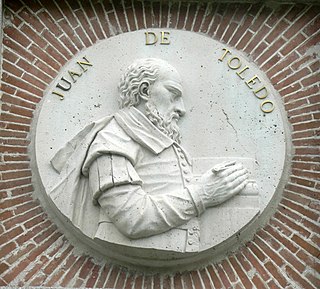
Juan Bautista de Toledo was a Spanish architect. He was educated in Italy, in the Italian High Renaissance. As many Italian renaissance architects, he had experience in both architecture and military and civil public works. Born, either in Toledo or in Madrid around 1515. He died on 19 May 1567 in Madrid, and was buried in Madrid in the choir of the primitive “Convento de Santo Tomás, Iglesia de la Santa Cruz”.

The Palmeral or Palm Grove of Elche is the generic name for a system of date palm orchards in the city of Elche, Spain.
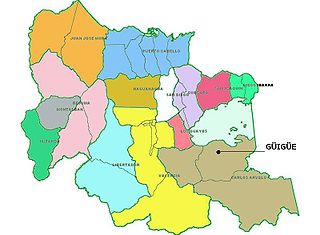
Guigue is a city in the south of the Valencia Lake, in Carabobo, Venezuela. It is the capital of the Carlos Arvelo Municipality and of the Guigue parish. The Guigue River flows through the city, draining in Lake Valencia.
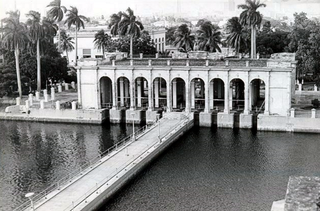
The Acueducto de Albear is the name of a water supply system of the city of Havana, Cuba, built in the 19th century by Francisco de Albear.

Río Portugués is a river in the municipality of Ponce, Puerto Rico. In the 19th century, it was also known as Río de Ponce. Twenty-one bridges for motor vehicle traffic span Río Portugués in the municipality of Ponce alone. The river is also known as Río Tibes in the area where it flows through barrio Tibes in the municipality of Ponce. Río Portugués has a length of nearly 30 kilometers (19 mi) and runs south from the Cordillera Central mountain range into the Caribbean Sea. The Portugués is one of the best-known rivers in Ponce because of its prominent zigzagging through the city and its historical significance. The river is historically significant because the city of Ponce had its origins on its banks. It was originally known as Río Baramaya. It has its mouth at 17°58′51″N66°37′26″W. This river is one of the 14 rivers in the municipality.

The Cenia is a coastal river in Spain that flows through the eastern part of the Iberian Peninsula. Along a significant portion of its course, it acts as a border between the provinces of Castelló and Tarragona. It has a length of 50 km and it flows into the Mediterranean Sea.
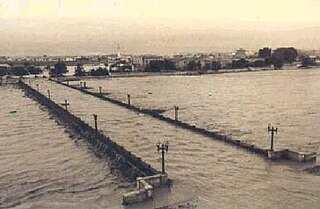
The 1957 Valencia flood was a natural disaster that occurred on 14 October 1957 in Valencia, Spain. The flood resulted in significant damage to property and caused the deaths of at least 81 people. In response to the tragedy, the Spanish government devised and enacted the Plan Sur, which rerouted the city's main river, the Turia.

The Carraixet ravine is a course of water from the north of the Valencian province, in the Valencian Community (Spain). It begins in Gátova and collects waters from the sloped southern side of the Calderona mountain range. It flows into the Mediterranean Sea through the town of Alboraya. At its mouth, it is also called the Olocau ravine or the Peralvillo ravine. In the Book of the Facts James I named it riu Sec, while discussing the Battle of the Puig.

The Acueducto de Ponce, formally Acueducto Alfonso XII, is the name of a historic 2.5-mile gravity-based water supply system in the city of Ponce, Puerto Rico. It was designed in 1875 by Timoteo Luberza and built the following years. This aqueduct was the first modern water distribution system built in Puerto Rico. The Aqueduct was known as El Puente de los Suicidios. It was declared a National Historic Monument on 17 June 2015.
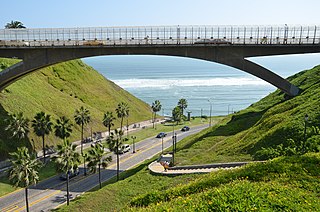
Eduardo Villena Rey Bridge is an arch bridge in Miraflores, Lima, Peru. It joins the Malecón de Miraflores and crosses the Bajada Balta.

The Albufera Natural Park or simply La Albufera is a Spanish protected natural area located in the province of Valencia, Valencian Community. It was also known by the Romans as Nacarum Stagnum and in some Arabic poems it is called Mirror of the Sun.
Canelon, Luis Heraclio Medina. "Tres Historias Del Cabriales: Canalización, Suicidios y Puentes Caídos". TRES HISTORIAS DEL CABRIALES: CANALIZACIÓN, SUICIDIOS Y PUENTES CAÍDOS, 1 Jan. 1970, http://cronicasyotrashistorias.blogspot.com/2020/01/tres-historias-del-cabriales.html.